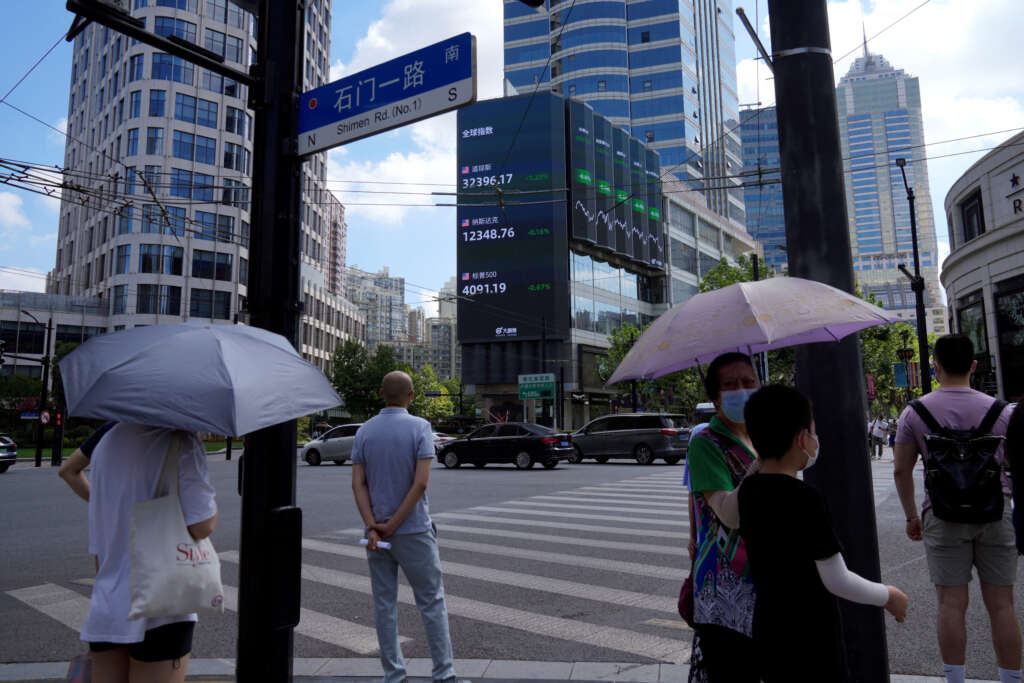
By Wayne Cole
SYDNEY (Reuters) – Asian shares slipped on Monday and the dollar extended its climb amid angst over global growth as most central banks keep raising rates, while a modest easing by China served only to highlight troubles in its property market.
U.S. Federal Reserve Chair Jerome Powell headlines a host of policy makers at Jackson Hole later in the week and the risks are that he will not meet investor hopes for a dovish pivot on policy.
“We expect a reminder that more tightening is needed and there is still a lot of progress to be done on inflation, but no explicit commitment to a specific rate hike action for September,” said Jan Nevruzi, an analyst at NatWest Markets.
“For markets, a bland delivery like that could be underwhelming.”
Futures are fully priced for another hike in September, with the only question being whether it will be 50 or 75 basis points. Rates are seen reaching 3.5% to 3.75% by year end.
A Reuters poll of economists forecast the Fed will raise rates by 50 basis points in September, with the risks skewed towards a higher peak.
One exception to the tightening trend is China, where the central bank trimmed some key lending rates by between 5 and 15 basis points on Monday in a bid to support a slowing economy and a stressed housing sector.
Unease over China’s economy tipped the yuan to a 23-month low, while pressuring stocks across the region.
MSCI’s broadest index of Asia-Pacific shares outside Japan fell a further 0.6%, though Chinese blue chips did manage to gain 0.7%.
South Korea’s KOSPI shed 1.3% while Japan’s Nikkei fell 0.5%, though it has drawn support from the recent sharp reversal in the yen.
EUROSTOXX 50 futures lost 0.2% and FTSE futures 0.1%. S&P 500 futures eased 0.5% and Nasdaq futures 0.6%.
The S&P 500 has repeatedly failed to clear its 200-day moving average around 4,320 and ended last week down 1.2%.
BofA’s latest survey of investors found most were still bearish, though 88% did expect lower inflation over time, the highest proportion since the financial crisis.
“That helps explain this month’s rotation into equities, tech and discretionary, and out of defensives,” said BofA strategist Michael Hartnett. “Relative to history, investors are still long defensives and short cyclicals.”
He remained a cautious bear, given rising interest rates, and recommended fading further S&P rallies above 4,328.
YIELDS SPIKE
Equity valuations were not helped by a steep rise in global bond yields last week. British 10-year yields climbed by the most in five years following a shock inflation report, while bund yields jumped on a sky-high rise in German producer prices.
Ten-year Treasury yields rose 14 basis points over the week and last stood at 2.98%, while the curve remained deeply inverted to reflect the risk of recession. [US/]
The general air of global uncertainty has tended to boost the U.S. dollar as the most liquid of safe havens, leaving it up at 108.22 on a basket of currencies. Last week, it jumped 2.3% in its best performance since April 2020. [USD/]
“The USD can track above 110.00 this week if the August flash PMIs for the major economies show a further slowing in economic growth or contraction in activity,” said Joseph Capurso, head of international economics at CBA, referring to surveys of manufacturing due on Tuesday.
“We also expect Powell to deliver a hawkish message about inflation, in line with recent comments from other Fed officials supporting the USD.”
The dollar was firm at 137.25 yen, having shot up 2.5% last week, while the euro was struggling at $1.0036 after losing 2.2% last week.
Minutes of the European Central Bank’s last policy meeting are due this week and are likely to sound hawkish, since they decided to hike by 50 basis points.
The rise in the dollar has been a setback for gold, which was pinned at $1,745 an ounce. [GOL/]
Oil prices were also under pressure, amid worries about global demand and the high dollar, as well as consultations between the United States and the European Union on Iran’s response to the latest nuclear pact proposal. [O/R]
Brent was down $1.23 at $95.49, while U.S. crude lost $1.24 to $89.53 per barrel.
(Reporting by Wayne Cole; Editing by Shri Navaratnam and Clarence Fernandez)


